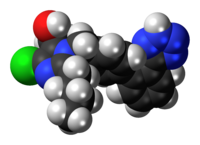Losartan
 | |
 | |
| Clinical data | |
|---|---|
| Trade names | Cozaar |
| AHFS/Drugs.com | Monograph |
| MedlinePlus | a695008 |
| License data | |
| Pregnancy category |
|
| Routes of administration | Oral |
| ATC code | |
| Legal status | |
| Legal status | |
| Pharmacokinetic data | |
| Bioavailability | 25–35% |
| Protein binding | 99.7% (primarily albumin) |
| Metabolism | Hepatic (CYP2C9, CYP3A4) |
| Elimination half-life | 1.5–2 hours |
| Excretion | Renal 13–25%, biliary 50–60% |
| Identifiers | |
| |
| CAS Number | |
| PubChem CID | |
| IUPHAR/BPS | |
| DrugBank | |
| ChemSpider | |
| UNII | |
| KEGG | |
| ChEBI | |
| ChEMBL | |
| CompTox Dashboard (EPA) | |
| ECHA InfoCard | 100.110.555 |
| Chemical and physical data | |
| Formula | C22H23ClN6O |
| Molar mass | 422.91 g/mol g·mol−1 |
| 3D model (JSmol) | |
| |
| |
| (verify) | |
Losartan (rINN) /loʊˈsɑːrtən/ is an angiotensin II receptor antagonist drug used mainly to treat high blood pressure (hypertension). It was the first angiotensin II antagonist to be marketed. Losartan potassium is marketed by Merck & Co. Inc. under the trade name Cozaar, and is available in generic form.
Medical uses
As with all angiotensin II type 1 receptor (AT1) antagonists, losartan is indicated for the treatment of hypertension. It may also delay progression of diabetic nephropathy and is associated with a positive clinical outcome in that regard. It is a suitable pharmacological agent for the reduction of renal disease progression in patients with type 2 diabetes, hypertension, and microalbuminuria (>30 mg/24 hours) or proteinuria (>900 mg/24 hours).[2]
Although clinical evidence shows calcium channel blockers and thiazide-type diuretics are preferred first-line treatments for most patients (due to both efficacy and cost), an angiotensin II receptor antagonist such as losartan is recommended as first-line treatment in patients under the age of 55 who cannot tolerate an ACE inhibitor.[3] The LIFE study demonstrated losartan was significantly superior to atenolol in the primary prevention of adverse cardiovascular events (myocardial infarction or stroke), with a significant reduction in cardiovascular morbidity and mortality for a comparable reduction in blood pressure. A study hints that losartan has a beneficial effect on mitochondria by reversing age related dysfunction in maintaining normal blood pressure and cellular energy usage.[4][5] The maximal effects on blood pressure usually occur within 3–6 weeks of starting losartan.[6]
Losartan is also available as hydrochlorothiazide/losartan, a combination drug with a low-dose thiazide diuretic to achieve an additive antihypertensive effect.
Mechanism of action and pharmacological actions
Losartan is a selective, competitive angiotensin II receptor type 1 (AT1) antagonist, reducing the end organ responses to angiotensin II. Losartan administration results in a decrease in total peripheral resistance (afterload) and cardiac venous return (preload). All of the physiological effects of angiotensin II, including release of aldosterone, are antagonized in the presence of losartan. Reduction in blood pressure occurs independently of the status of the renin-angiotensin system. As a result of losartan dosing, plasma renin activity increases due to removal of the angiotensin II feedback.
Losartan is a uricosuric. As a specific inhibitor of the urate transporter 1 (URAT 1), losartan blocks the uptake of uric acid into cells, thus leaving more available in the bloodstream to be filtered and excreted by the kidneys.[7] Because losartan can cause hyperkalemia, individuals should not use potassium supplements or salt substitutes containing potassium without appropriate monitoring by a physician.[8]
Pharmacokinetics
Losartan is well absorbed following oral administration and undergoes significant first-pass metabolism to produce the 5-carboxylic acid metabolite, designated as EXP3174. About 14% of an oral dosage is converted to this metabolite, which is long-acting (6 to 8 hr) and a noncompetitive antagonist at the AT1 receptor, contributing to the pharmacological effects of losartan. EXP3174 is 10-40 times more potent in blocking AT1 receptors than losartan. Losartan's bioavailability is about 32%.
Metabolism is primarily by cytochrome P450 isoenzymes CYP2C9 and CYP3A4. Peak plasma concentrations of losartan and EXP3174 occur about one hour and three to four hours, respectively, after an oral dose. Both losartan and EXP3174 are more than 98% bound to plasma proteins. Losartan is excreted in the urine, and in the feces via bile, as unchanged drug and metabolites. About 4% of an oral dose is excreted unchanged in urine, and about 6% is excreted in urine as the active metabolite. The terminal elimination half lives of losartan and EXP3174 are about 1.5 to 2.5 hours and 3 to 9 hours, respectively.
Losartan and other angiotensin-receptor antagonists exhibit fetal toxicity and should be avoided during pregnancy, particularly in the second and third trimesters.[9]
Adverse effects
In January 2014, the FDA issued a black box warning that losartan can cause fetal toxicity, and should be discontinued as soon as pregnancy is detected.[10] Using losartan while pregnant could result in fetal injury or death.[10]
The most common side effects for losartan are upper respiratory infections or stuffy nose, dizziness, and back pain.[11] Type 2 diabetics with diabetic kidney disease may experience diarrhea, fatigue, low blood pressure, low blood glucose, elevated potassium, and chest pain.[11]
More serious side effects include low blood pressure and allergic reaction.[11]
Contraindications
Losartan should not be taken by patients who are diabetic and taking aliskiren.[12]
See also
- Hypertension
- Discovery and development of angiotensin receptor blockers
- Hydrochlorothiazide/losartan
References
- ^ "FDA-sourced list of all drugs with black box warnings (Use Download Full Results and View Query links.)". nctr-crs.fda.gov. FDA. Retrieved 22 Oct 2023.
- ^ Boersma C, Atthobari J, Gansevoort RT, de Jong-Van den Berg LT, de Jong PE, de Zeeuw D, Annemans LJ, Postma MJ (2006). "Pharmacoeconomics of angiotensin II antagonists in type 2 diabetic patients with nephropathy: implications for decision making". PharmacoEconomics. 24 (6): 523–35. doi:10.2165/00019053-200624060-00001. PMID 16761901.
- ^ http://www.nice.org.uk/nicemedia/pdf/CG034NICEguideline.pdf, p19
- ^ "Switch in cell's 'power plant' declines with age; rejuvenated by drug". Johns Hopkins Medicine. August 16, 2011.
- ^ Abadir PM, Foster DB, Crow M, Cooke CA, Rucker JJ, Jain A, Smith BJ, Burks TN, Cohn RD, Fedarko NS, Carey RM, O'Rourke B, Walston JD (2011). "Identification and characterization of a functional mitochondrial angiotensin system". Proc. Natl. Acad. Sci. U.S.A. 108 (36): 14849–54. doi:10.1073/pnas.1101507108. PMC 3169127. PMID 21852574.
- ^ Abrams A (2007). 'Clinical Drug Therapy Rationales for Nursing Practice. Philadelphia, Pa.: Lippincott Williams & Wilkins. p. 846. ISBN 0-7817-6263-4.
- ^ Hamada T, Ichida K, Hosoyamada M, Mizuta E, Yanagihara K, et al. (2008) "Uricosuric action of losartan via the inhibition of urate transporter 1 (URAT 1) in hypertensive patients". Am J Hypertens 21:1157–1162.
- ^ RxList. The Internet Drug Index. Clinical pharmacology of Cozaar. Retrieved January 6, 2014.
- ^ Sica DA, Gehr TW, Ghosh S (2005). "Clinical pharmacokinetics of losartan". Clin Pharmacokinet. 44 (8): 797–814. doi:10.2165/00003088-200544080-00003. PMID 16029066.
- ^ a b "Cozaar (losartan potassium) 25 mg, 50 mg, and 100 mg Tablets". fda.gov. Retrieved 21 July 2015.
- ^ a b c http://www.merck.com/product/usa/pi_circulars/c/cozaar/cozaar_ppi.pdf
- ^ http://www.accessdata.fda.gov/drugsatfda_docs/label/2014/020386s060lbl.pdf
